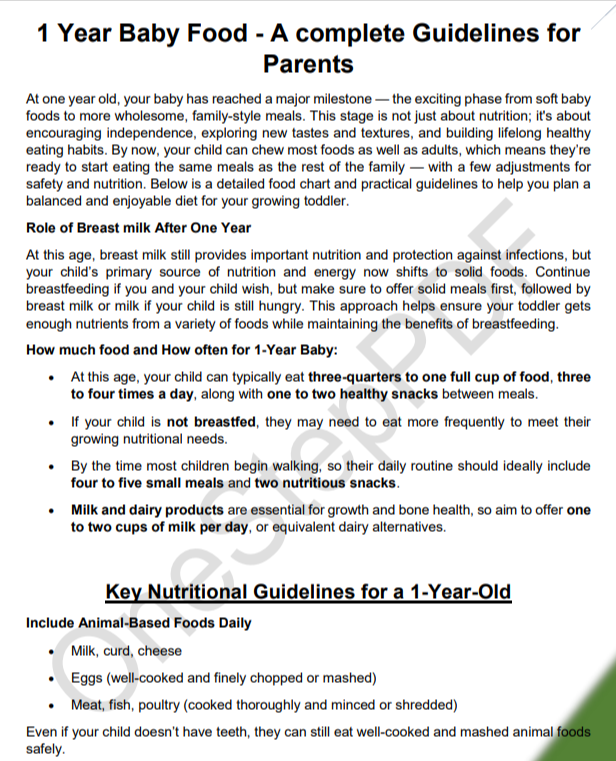1 Year Baby Food Chart
1 Year Baby Food Chart- A complete guidelines for Parents
At one year old, your baby has reached a major milestone — the exciting phase from soft baby foods to more wholesome, family-style meals. This stage is not just about nutrition; it’s about encouraging independence, exploring new tastes and textures, and building lifelong healthy eating habits. By now, your child can chew most foods as well as adults, which means they’re ready to start eating the same meals as the rest of the family — with a few adjustments for safety and nutrition. Below is a detailed food chart and practical guidelines to help you plan a balanced and enjoyable diet for your growing toddler.
Role of Breast milk After One Year
At this age, breast milk still provides important nutrition and protection against infections, but your child’s primary source of nutrition and energy now shifts to solid foods. Continue breastfeeding if you and your child wish, but make sure to offer solid meals first, followed by breast milk or milk if your child is still hungry. This approach helps ensure your toddler gets enough nutrients from a variety of foods while maintaining the benefits of breastfeeding.
How much food and How often for 1-Year Baby:
- At this age, your child can typically eat three-quarters to one full cup of food, three to four times a day, along with one to two healthy snacks between meals.
- If your child is not breastfed, they may need to eat more frequently to meet their growing nutritional needs.
- By the time most children begin walking, so their daily routine should ideally include four to five small meals and two nutritious snacks.
- Milk and dairy products are essential for growth and bone health, so aim to offer one to two cups of milk per day, or equivalent dairy alternatives.
Key Nutritional Guidelines for a 1-Year-Old
Include Animal-Based Foods Daily
- Milk, curd, cheese
- Eggs (well-cooked and finely chopped or mashed)
- Meat, fish, poultry (cooked thoroughly and minced or shredded)
Even if your child doesn’t have teeth, they can still eat well-cooked and mashed animal foods safely.
Include Plant-Based Proteins
- Include protein rich foods like lentils, chickpeas, peas, and toor/moong dal
- Offer nut-based options, such as smooth peanut butter or finely ground nuts
- Offer Rice, wheat, oats, suji, ragi, millets in the form of Porridge, khichdi, upma, dosa, idli, roti
- Prepare a nutritious porridge using a homemade health mix made from a blend of grains and nuts. Its perfect for growing toddlers.
Note: Whole nuts are a choking hazard and should be avoided.
Add Fruits & Vegetables
- Offer green vegetables like carrot, pumpkin, spinach, sweet potato, bottle gourd, peas (mashed or cooked until soft)
- Include a variety of fresh fruits such as banana, apple, papaya, mango, orange, avacado,
Note: Serve steamed/boiled/pureed and well mashed or soft-cooked
Healthy Fats for Energy
- Add a small amount of ghee, butter, or oil to your baby’s meals for extra energy and taste.
Healthy Snacks
- Choose snacks like fresh fruits, boiled sweet potato, vegetable sticks, home-made (grain/veg) rotis, or homemade multigrain biscuits instead of sugary or processed snacks.
1 Year Baby Food Chart
| Early Morning |
Breastmilk, formula, or cow’s milk (150–200 ml) |
| Morning |
- Idli with ghee/Dal
- Vegetable poha
- Dosa with coconut chutney
- Mashed banana/Apple/chikoo
- Suji porridge/Halwa
- Boiled Egg Yolk
- Home-made Health mix Porridge
|
| Mid Morning |
- Soft apple slices
- Mashed banana/Apple/chikoo
- Boiled carrots, potato or peas
|
| Lunch |
- Rice with dal and vegetables
- Rice with Veg/Meat Soup
- Curd rice with Vegetables
- Khichdi with soft-cooked vegetables
Add Ghee/Oil for Extra Energy |
| Afternoon snack |
- Panner Cubes
- Fruit smoothie
- Mashed Fruits
|
| Evening Snack |
- Vegetable Cutlet
- Boiled Potato/Sweet Potato
- Whole wheat , Ragi Home-made Biscuits
- Grain/Veg Rotis
|
| Dinner |
- Soft chapati with dal and mashed vegetables
- Vegetable upma
- Moong dal rice
- Idli/ Dosa with Milk/Ghee/Vegetables
|
| Before Bed |
Breastmilk or cow’s milk (100-150 ml) |
Foods to Avoid for 1-Year baby
- Whole nuts (choking hazard)
- Honey (risk of infant botulism if under 1 year)
- Excessive sugar and salt
- Spicy or oily foods
- Unpasteurized dairy products
- Processed/junk food (chips, packaged snacks)
Feeding Tips for 1-Year-Olds
- Introduce new foods one at a time to monitor allergies.
- Keep meals low in salt and sugar.
- Offer finger foods to encourage self-feeding.
- Make meals colorful, soft, and bite-sized.
- Avoid choking hazards like whole nuts, hard candies, or popcorn.
- Encourage family meals to model good eating behavior.
- Let your child decide how much to eat — don’t force-feed.
When to See a Pediatrician
You should contact your child’s doctor if:
- Your baby consistently refuses to eat solid foods
- There is frequent vomiting or diarrhea after meals
- Your child shows signs of an allergic reaction (such as rash, swelling, or hives)
- Your baby appears underweight or is not gaining weight as expected
- Regular check-ups also help ensure your child is meeting developmental and nutritional milestones.
The first year marks the beginning of your baby’s lifelong relationship with food. With patience, consistency, and a variety of home-cooked, nutritious meals, your child will learn to enjoy eating and develop healthy habits. Messy mealtimes, food refusal, and preference changes are completely normal — don’t stress. Keep offering balanced foods with love, and trust your baby’s natural hunger cues and instincts.
Download 1 Year Baby Food Chart PDF for Free
Download PDF

